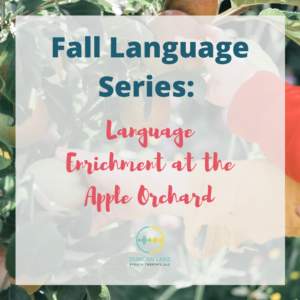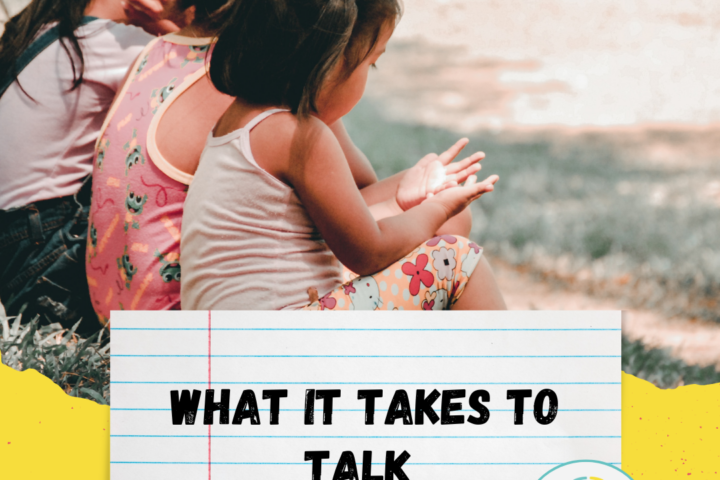Like any red-blooded Midwesterner, I am a sucker for the fall. Call me basic, but there is something about this time of year that just makes me so happy. Maybe it’s the colors? Maybe it’s the sweaters? Whatever it is, I love it!
Fall brings with it its own set of activities. Apple orchards, pumpkin patches, hay rides – the list goes on and on. So, for the fall season, I’m going to highlight several of these activities and how you can add a little extra kiddo-language enrichment to each. We’re really leaning into this!
I love an apple orchard. Between the actual apples and the cider and the doughnuts and the outdoorsy-nature of the activity, it hits all the marks for me. To kick off this series, then, let’s talk about apple orchard visits this week. How can you add a language boost to this outing?

Verbs
Think of all of the amazing verbs that can be modeled at an apple orchard. For our young learners, try saying and modeling verbs like, “pick,” “pull,” “eat,” and “drop.” Make sure your kiddo is looking at what you’re doing, too! For older children, you can model these verbs in sentences. Try messing around with the tenses. “Let’s go pick some apples.” “Look, they are picking apples!” “I’m so tired. We picked so many apples today.” By modeling these sentence structures, you’re giving your child a framework from which they can form sentences later.
You can also try to come up with new verbs for commonly used ones. For instance, instead of saying, “Let’s run to the trees,” you could swap out run with words like “sprint” or “dash.”
Describing
Description is one of the most foundational language skills. However, it’s kind of hard for us as adults to teach it sometimes. I mean, what else can you say about, say, a banana? It’s yellow? It’s…banana-shaped?
Try this.
An apple orchard provides about 7 million opportunities to describe items. I like to break it down like this: category, function, appearance, what it’s made of, parts, where you’d find it (otherwise known as the Expanding Expression Tool). Pick a few of these and roll with it. For instance, an apple – “An apple is a round fruit that can be red, yellow, or green. It grows on trees, and we eat them!” While it’s good to point out how things look, it’s also important to find other ways to describe them. Try using that format when describing items on your trip – apples, trees, baskets, doughnuts (yes), and hay!
Vocabulary
The apple orchard can offer a variety of new words your child might not know. Think about it – bushel, hay bale, and core (of an apple) are not words we use on a regular basis. Use this opportunity to teach the new vocabulary. You can point out objects and name them, but even better? You can use them in sentences. Model what the words mean. For example, for the word bushel, you could say, “This is a bushel of apples. A bushel is big basket-full of apples. Could you eat this whole bushel?!”
Social Skills
Well, pre-COVID, the apple orchard would’ve been a great place for your kids to interact with other children. Families visit these places in droves during the fall, so there would have been ample opportunity to have an impromptu play date. Given the 6 foot guidelines, that has become a bit harder. HOWEVER, there are still a number of social skills your child can learn while on the apple orchard. Have them be a part of the payment interaction when you’re buying apples. Model polite forms (please, thank you) as well as greetings. This will also be a great opportunity to practice turn-taking, a huge social skill. Maybe each sibling gets a boost from their parent to pick some apples, requiring all of them to take turns. Maybe the orchard will be so crowded that other people will need to finish before you can start picking.
All of these skills are good to practice!
Prediction (and some sneaky feeding)
Try giving your child a variety of different apple slices to try. Have them predict what each one will taste like (sweet? sour?). Which one will be the crunchiest? Make it fun! This is also a wonderful opportunity to practice expanding your child’s palate (remember our picky eating video?). Give them a variety of colors to test out and see what happens.
By incorporating these simple strategies into your trip, you can help boost your child’s language development while still having fun!




